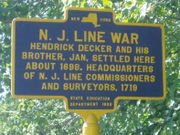The War between the States
We cycled out of Ulster County into the neighboring Orange County, and noticed that the communities we passed through were less well kept, and that the ethnic makeup had changed. For what it’s worth, most of our riding has been through areas where the vast majority of the population is Caucasian. But in this locale, 30 or so miles from the Big Apple, we noticed a large number of Hispanics and African Americans. We are not making a social commentary here, just reporting on what we observed along the route. In Middleton NY we entered from the north, and as we rode into town, the streets became lined with what we could only describe as tenement style housing. The neighborhood was decidedly different…run down, ill kept, yet just a few blocks away there were stately Victorian style homes with freshly mowed lawns and well tended flower gardens. The dichotomy was striking and somewhat disturbing to us. We have since learned that this would not be an isolated incidence, as we have seen the same pattern repeated in other communities that once had an industrial base of some sort, but now serve as a place where cheap housing can be found somewhat near a metropolitan area. It gave us pause to reflect…we’ve seen incredible wealth on our journey. Mansions, horse farms, resort areas, affluent suburbs, and now this. While we have seen areas of rural “poverty”, the disparity in Middleton hit us right between the eyes and still haunts us today.
Leaving Middleton, the climbing began in earnest as this was our last pull “over the hump” from the Hudson Valley. We crested somewhere outside of Otisville and enjoyed a bell ringing 2 mile downhill to the town of Cuddlebackville where we crossed the Neversink River and the region of the New York-New Jersey Line War of the 1700s.
The Civil War is undoubtedly the greatest conflict between states that our nation has ever faced. However, border wars were not unusual in the early days of settlements of the colonies and originated in conflicting land claims. Because of ignorance, willful disregard, and legal ambiguities, such conflicts arose involving local settlers until a final settlement was reached.

The New York–New Jersey Line War refers to a series of skirmishes and raids that took place for over half a century between 1701 and 1765 at the disputed border between them. What precipitate this “war” was that the northbound extension of New Jersey was not respected by settlers from New York who moved westward from Orange County. The resulting conflict was carried out by settlers from both sides. In addition, these settlers had to fight off Native Americans who also raided the area during the French and Indian War.
The last fight broke out in 1765, when the Jerseyans attempted to capture the leaders of the New York faction. Because the fight took place on the Sabbath, neither side used weapons. The New York leaders were captured and kept briefly in the Sussex County jail.
The conflict was eventually settled. The King of England appointed commissioners to establish what would become the permanent and final border that runs southeast from the Delaware River near Port Jervis to the Hudson River. The New York and New Jersey legislatures ratified the compromise in 1772, and the King approved it in 1773.
All along this section of the route were historic markers commerating the "Line War" or the hostilities of the French and Indian War. We turned onto a lovely county road at Hugenot, and rode the 5 or so miles into Port Jervis without seeing another soul. Crossing the now undisputed line into New Jersey, we were anxiously anticipating arriving at the campsite designated on the map. This was a long, tiring day...59 miles to be precise, and with the sun setting earlier each day, we needed to get situated, camp set, and dinner cooked. The map was indeed accurate (again) and we pulled into camp around 6 PM. It was a long haul, and after taking showers we hit the air matresses before 9 for a well earned rest.

0 Comments:
Post a Comment
<< Home